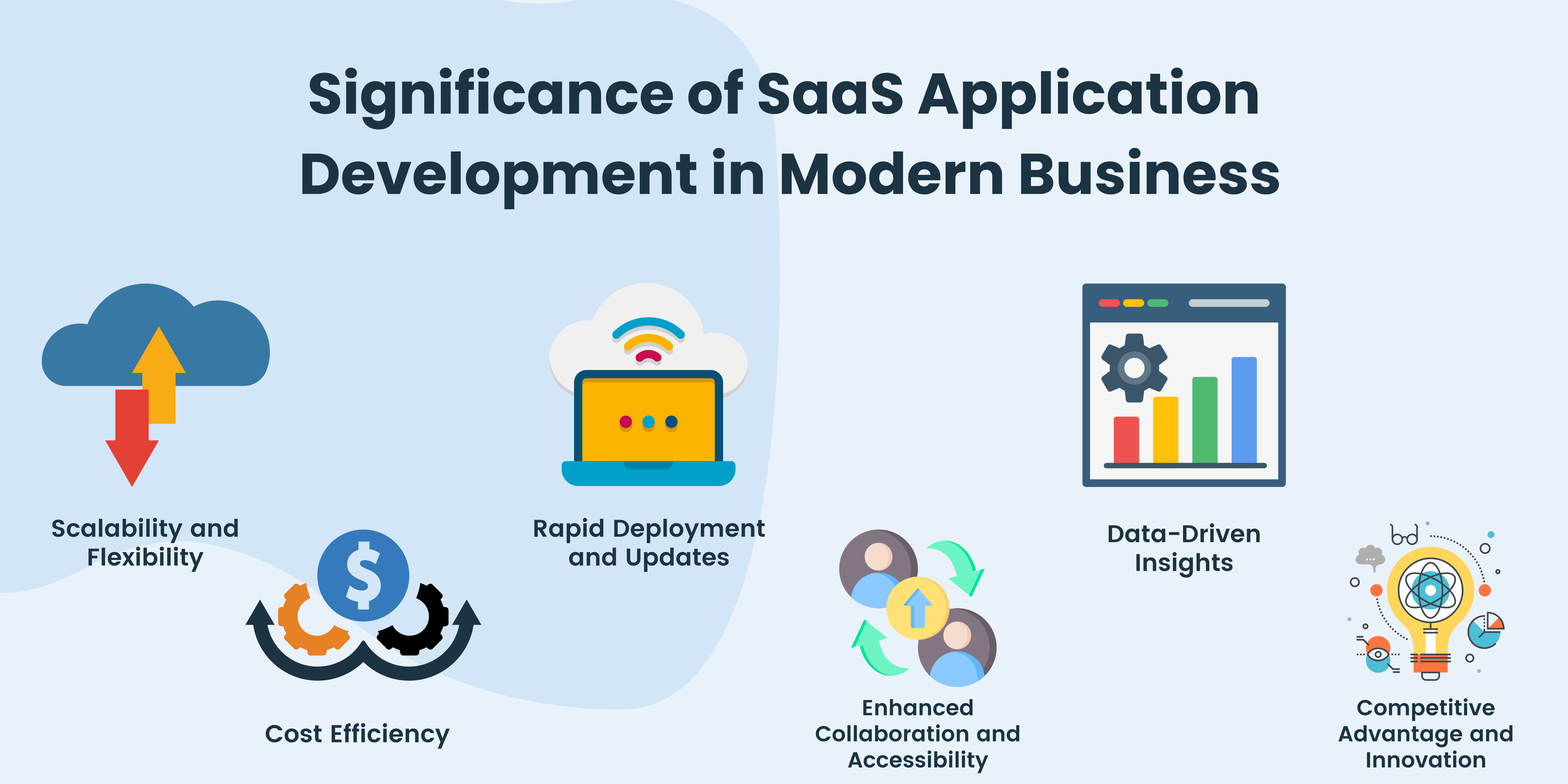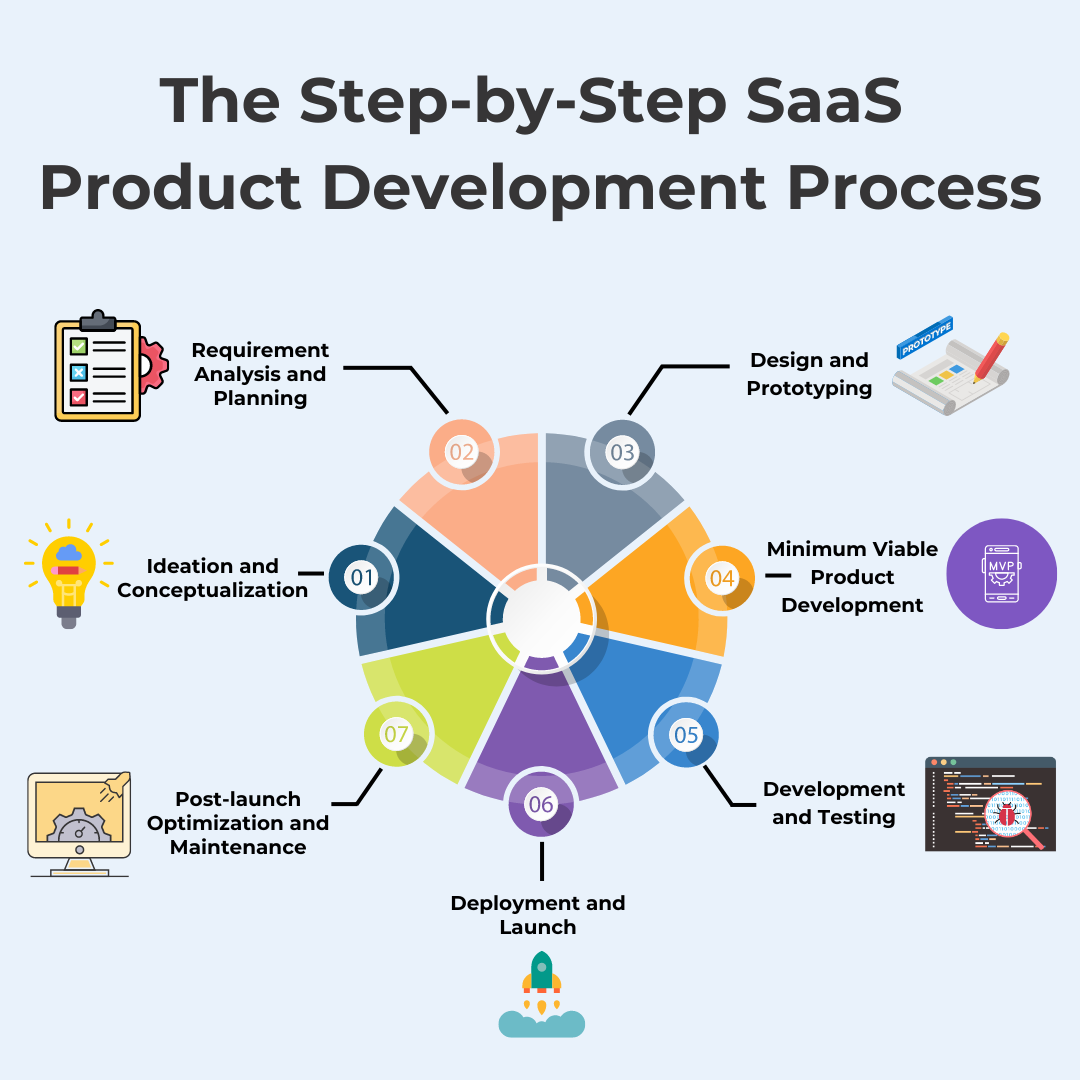Ready to undertake your SaaS-based product development voyage? Now is the right time for businesses to move ahead with SaaS products.
SaaS development symbolizes a paradigm transformation in companies ideating, developing, and providing users with software solutions. By adopting the SaaS standard, companies can open unexplored possibilities for creation, skillfulness, and evolution while managing digital consumer’s growing necessities and preferences. Whether establishing a contemporary SaaS product or altering from standard software pinnacles, enterprises profit from the scalability, accessibility, and cost-efficiency of application development.
Software as a Service product have appeared as an altering power in the rapidly maturing digital landscape, changing how enterprises provide and utilize software solutions. From new startups to well-established multinational corporations, institutions shift to SaaS to facilitate processes, improve productivity, and propel transition. This complete guide analyzes the intricacies of SaaS product development services and uncovers their benefits. It also outlines a step-by-step process to help businesses move toward the successful journey of developing a SaaS product.
Decoding the SaaS Tapestry and Navigating SaaS Software Development in the Technological Era
Diving deep into software as a service (SaaS), the guide functions as a beacon for enterprises, innovators, and corporations seeking to dominate the skill of building a SaaS solution. By comprehending the intricacies of SaaS software development, businesses will be provided with valuable insights and techniques to steer through the wave of transformation. From gathering the information to deployment, we will help you understand the significant regulations, procedures, and most suitable approaches.
SaaS Unveiled: Demystifying The SaaS Product Meaning
Software as a Service brings the concept of a cloud-based software allocation standard into the light. SaaS applications are transformed when deployed and harbored by a third-party development provider and made public to users online. Unlike conventional softwares that requires installation in context to the premise, SaaS products can be utilized through web browsers, for instance, a SaaS platform like Canva. They give users the flexibility to operate from anywhere with an internet connection. Being on the cloud, the SaaS software changes the functioning of businesses and ensures seamless workflow.
Unlocking Innovation with the Significance of SaaS Application Development in Modern Business
SaaS product development stands at the vanguard of technological invention, enabling essential transformations in how enterprises function and operate solutions. Its essence surpasses mere comfort and is necessary for systematic business growth and sustainability through different verticals. Adopting a systematic and organized SaaS product development strategy offers businesses many benefits. For instance, below are examples:

1. Scalability and Flexibility
SaaS offers phenomenal scalability, qualifying firms to adjust their solutions to modify necessities and inconsistent demands. The use provides flexibility and entrusts companies to scale their business processes efficiently without the limitations of standard software infrastructure.
2. Cost Efficiency
Existing software development often demands substantial capital investment in infrastructure, clearances, and supervision. SaaS software development functions on a subscription-based standard, proposing predictable expenditure systems and eradicating the necessity for sturdy initial investments. With a SaaS application development company, the cost-effectiveness normalizes access to cognitive solutions, particularly for new startups and small and mid-sized businesses with restricted aids.
3. Rapid Deployment and Updates
SaaS facilitates prompt deployment of solutions, particularly declining time-to-market compared to conventional development techniques. Moreover, constant updates and modifications are delivered to users without affecting the procedures, guaranteeing enterprises can always access emerging features and improve security.
4. Enhanced Collaboration and Accessibility
SaaS products encourage smooth team collaboration, regardless of location or time zone. Employees can collaborate in real-time with a cloud-based facility, promoting efficiency and creation. Further, the capability and accessibility of SaaS solutions from any internet-based device entrust enterprises to welcome remote work norms and adjust to the altering landscape of contemporary workplaces. Such enhanced collaboration and accessibility is possible with the assistance of a SaaS based product development company chosen specifically for next-generation solutions.
5. Data-Driven Insights
SaaS platforms gather extensive user data and information for businesses, offering them beneficial insights into customer conduct, selections, and market trends. Enterprises can incorporate intelligence to move toward knowledgeable decision-making, optimize user experiences, and ensure product performance through artificial intelligence development.
6. Competitive Advantage and Innovation
Adopting SaaS app development facilitates companies to gain a competitive edge by innovating and yielding exceptional customer experiences. Enterprises can rapidly emphasize, investigate, and innovate by utilizing cloud-native technologies, microservices architecture, and DevOps approaches to fulfill ripening customer expectations and market needs.
Essentially, a SaaS development agency helps businesses outperform established software delivery standards, entrusting companies to discover unexplored possibilities, elevating functional efficiency, and encouraging business growth. By incorporating the transformative opportunity of SaaS, enterprises can accelerate their functions, remain agile in an active marketplace, and prosper in a corresponding world.
The Step-by-Step SaaS Product Development Process
The software as a service market was estimated to be $197 billion in 2023 and will reach $232 billion by 2024, as per Statista. In the engaged topography of contemporary enterprises, how to build a SAAS product is a significant question. Utilizing SaaS solutions is necessary for staying competitive and fulfilling customer requests. Whether you’re a new venture planning to climb the ladder or an established business striving for digital transformation, comprehending the step-by-step SaaS product development process is necessary. Let us dive deep into each stage of product development and examine how companies can simplify the process.

1. Ideation and Conceptualization
Adopting a thriving SaaS product initiates with inventiveness and ideation. It is the first phase, where businesses determine market demands, perform competitor research, and specify a clear understanding of their product for development. Every crucial information is systematically organized, from brainstorming ideas sessions and understanding the target audience to creating product roadmaps to summarize essential features and functionalities. Keeping AWS in mind, the businesses should examine if the product concept fits AWS. With Amazon Web Services, they can ensure that their SaaS product is functional for AWS.
2. Requirement Analysis and Planning
Once the product concept is decided upon and a concrete idea of business needs is developed, the subsequent step concerns executing a comprehensive necessity examination and planning phase. Businesses meet with stakeholders, collect and understand user feedback, build SaaS implementation plans, and determine project capacity, purposes, and conquest benchmarks. Further, this phase entangles the allocation of resources, understanding capital investment, and creating project timelines to guarantee on-time delivery.
3. Design and Prototyping
With needs and requirements in hand, the emphasis shifts to making the user interface and experience during the SaaS development process. A prototype development company assembles mockups, wireframes, and prototypes to envision the layout of the product, ensure smooth navigation flow, and build interaction patterns. User feedback is surveyed through multiple usability tests and user-friendly SaaS product design cycles to redefine the user experience.
4. Minimum Viable Product Development
Building an MVP is essential during product development. It authorizes enterprises to validate their ideas and understand the feasibility of their product with minimal aid and comprehension based on genuine user feedback. With MVP development services, enterprises can define the needs for complex features and functionalities fundamental to the initial release. By delivering value to early adopters while keeping enterprise product development efforts lean, businesses can gather valuable insights, validate assumptions, and refine their product roadmap iteratively.
5. Development and Testing
Once the layout for the product is finalized, development teams initiate coding the product utilizing agile methodologies like Scrum. This stage entangles frontend and backend development, integration of third-party APIs, database and SaaS application design, and undertaking of security measures. With software testing services, quality assurance is executed to pinpoint and manage bugs, guarantee cross-browser compatibility, and ensure product functionality against predefined user and business acceptance standards.
6. Deployment and Launch
Following successful development and testing, the SaaS product is ready for deployment. This phase concerns configuring hosting infrastructure, positioning servers, and deploying the application. A launch strategy is performed to attract the audience, attract adopters, and drive user engagement through campaigns, press releases, and promotional activities to ensure conversion.
7. Post-launch Optimization and Maintenance
The path towards constructing a thriving SaaS product does not end with the deployment. Post-launch optimization and maintenance are necessary to handle user feedback, work on upcoming features, and improve the prevailing product experience. Continuous monitoring and reporting, product performance optimization, and regular updations ensure the growth of the SaaS product, boosting user satisfaction and increasing retention.
With the proper understanding of the development process, businesses can streamline their SaaS solutions according to their needs. Considering the entire process, the decision-makers have another question that varies the decision to develop SaaS solutions. What is the estimated capital investment when it comes to building enterprise-centric software? To clarify the cost, let us understand different aspects that can vary the expenditure.
What is the Estimated Cost to Build SaaS Product?
SaaS product development costs range from $40,000 to $500,000, depending on the project’s complexity. The cost to build SaaS products is influenced by features enforced, platforms supported, API integrations, estimated deadlines, and team location.
For instance, the complexity of your SaaS product can vary the estimated capital investment. A micro SaaS can cost up to $25,000, while a complex SaaS product with advanced and cognitive features can cost up to $500,000.
| SaaS Complexity | Average Cost |
| Micro SaaS | $10,000-$25,000 |
| Basic SaaS | $25,000-$50,000 |
| Average SaaS | $50,000-$150,000 |
| Complex SaaS | $150,000-$450,000 |
Multiple factors like the experience of the SaaS developers hired, the development company’s location, and industry understanding can affect the estimated cost. You can contact our professionals if you need a better understanding of the cost.
Why Choose SparxIT as your SaaS Product Development Company?
When evaluating a SaaS product development company, SparxIT stands out among the competitors as a technologically adept and forward-thinking choice. We have been delivering ever-evolving SaaS solutions with a focus on client satisfaction. SparxIT utilizes intelligent technologies to ensure business expansion and boost workflow efficiency. Our expertise in cloud-native architectures, DevOps practices, and microservices ensures that businesses receive products that are built, keeping the SaaS product development platforms for reliability, scalability, and performance.
Moreover, their expertise in contemporary development frameworks and languages facilitates prompt iteration and punctual delivery of highly functional software. By determining SparxIT as your SaaS product development partner, enterprises can tap into a wealth of technical know-how and experience, empowering them to stay ahead of the curve in today’s fast-paced digital landscape.

Ready to Unlock Success with SaaS Product Development?
Frequently Asked Questions
What is the difference between SaaS and traditional software?








SaaS development varies from traditional desktop or on-premise software in that it performs with the internet, finishing the requirement for separate downloads and computer installations. This facilitates allotment, maintenance, and updates, considering all users obtain them automatically. SaaS also means that SaaS product users subscribe to it daily rather than possessing it. Nevertheless, SaaS products may present restricted customization choices compared to traditional software, as it can only incorporate other cloud-based apps and products.
What is the estimated cost to build SaaS product?














Generally, the estimated cost to build SaaS product ranges from $40,000 to $500,000 without regard to continuous supervision and updates. Saas implementation costs range based on the extent of the project, the features needed, platforms, duration, etc.
What aspects affect the capital investment of building a SaaS product?














SaaS cost analysis relies on the features enforced, type of API integration, platform support, and development team establishment. Other aspects include project duration, complexity, and scalability needs.
What are the key capital investment components of SaaS product development?














SaaS application development includes UI/UX design expenses, front-end and back-end, quality testing, proper project management, and server configuration and hosting. Also, you should evaluate maintenance and support expenditures and the marketing budget.
Are there any continuing expenses after building a SaaS app?














Ongoing expenses may include server hosting fees, software updates and advancements, customer aid, marketing and promotion expenditures, and unexplored features and progress prices. Additionally, recall to scale up the allotment to endure increased use.
What duration does it take for SaaS software development?














The complexity of the SaaS software decides the course it will take. The more intricate the feature implementation, the longer it will take to produce a SaaS product. For instance, a straightforward SaaS app takes up to 3-4 months, while a complicated SaaS product can take up to 9-10 months.


